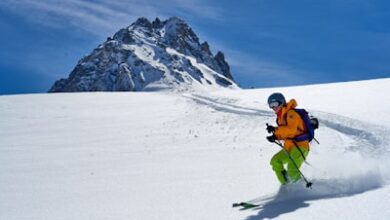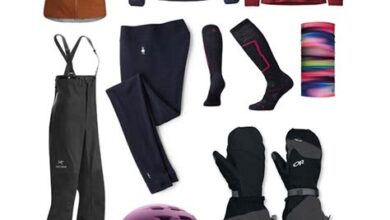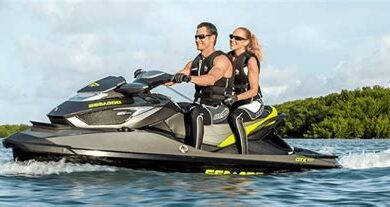Which Is A Recommended Water Skiing Safety Practice?⏬

Discover essential water skiing safety tips for beginners, intermediate, advanced skiers, kids, and adults to ensure a fun, secure experience.Water skiing offers a blend of exhilarating speed and refreshing splashes, making it an irresistible choice for aquatic adventurers. However, beneath the thrill lies the vital importance of safety. Whether you’re skimming across the water for the first time or are a seasoned veteran cutting through the wake, understanding and implementing safety measures is non-negotiable. In this blog, we’ll explore recommended water skiing safety practices tailored to different skill levels and ages. From beginners to advanced skiers, and from young enthusiasts to adults, we’ll cover essential tips to ensure that everyone enjoys the rush of the skis with peace of mind. Additionally, we’ll delve into universal safety practices that every water skier should embrace, regardless of their experience. So, before you strap on your skis and jump into the water, let’s dive into the safety practices that will keep your water skiing adventures both fun and safe.
Which Is A Recommended Water Skiing Safety Practice For Beginners?
Embarking on the thrilling journey of water skiing requires adherence to certain safety practices, particularly for beginners who are new to the sport. A crucial aspect of ensuring a safe experience is understanding and implementing recommended strategies that minimize risks on the water. Grasping these techniques not only enhances confidence but also lays a strong foundation for advancing to higher levels of water skiing proficiency.
One essential safety practice is the use of a life jacket or personal flotation device (PFD). Beginners should always wear a U.S. Coast Guard-approved life jacket that fits snugly while providing ample flexibility for movement. Ensuring that the life jacket is properly secured is a vital step that cannot be overlooked, as it serves as the first line of defense in the case of an unforeseen fall into the water.
Additionally, it is recommended for beginners to start with a spotter or an experienced water skiing partner. The spotter’s responsibility is to observe the skier from the boat and communicate with the driver in case of any mishaps, signaling when the skier falls and assisting in prompt rescue if necessary. This practice ensures that beginners are not left alone in the water, thus enhancing their safety during the early stages of learning.
Preparation and understanding of hand signals are also fundamental for safe water skiing. Beginners must familiarize themselves with the standardized signals used to communicate with the boat driver, such as indicating when to speed up, slow down, turn, or stop. Mastery of these signals contributes to clearer communication and incident prevention.
Finally, engaging in a certified instructional course is highly beneficial. Professional instructors can provide beginners with comprehensive safety information, proper technique, and personalized guidance. This structured learning approach equips new skiers with the knowledge and skills necessary to safely navigate the water, laying a solid groundwork for their water skiing journey.
| Recommended Practice | Description | Benefit |
|---|---|---|
| Wear a life jacket | Ensures flotation and safety in case of falls | First line of defense against drowning |
| Use a spotter | Observes skier and communicates with the driver | Enhances skier monitoring and quick rescue |
| Learn hand signals | Communicate with driver for speed and direction changes | Prevents miscommunication-related accidents |
| Instructional courses | Provides professional teaching and safety tips | Builds strong foundational skiing skills |
Which Is A Recommended Water Skiing Safety Practice For Intermediate Skiers?
Becoming an intermediate skier indicates that one has surpassed the basics of water skiing and is exploring more challenging techniques and water conditions. A recommended water skiing safety practice for intermediate skiers is to always maintain a proper lookout and remain aware of their surroundings. This means being vigilant about other watercraft, skiers, and potential hazards in the water.
It is also important to ski with a partner and to use a spotter. A spotter is an individual who stays in the boat to communicate between the skier and the driver. They keep an eye on the skier at all times, ready to alert the driver in case of any falls or signs of distress. The use of a spotter ensures that if an intermediate skier falls or needs assistance, help is swiftly on the way.
Another key safety practice is to wear a properly fitting life jacket. A life jacket, also known as a personal flotation device (PFD), is essential for keeping skiers afloat should they become fatigued or injured. It is not just a rule; it’s a crucial lifeline. Knowing how to select and wear a life jacket correctly is invaluable for intermediate skiers looking to enhance their safety on the water.
Lastly, understanding hand signals is a fundamental safety practice for intermediate skiers. Effective communication between the skier, the spotter, and the boat driver can prevent accidents and confusion. Below is a table illustrating some common hand signals utilized in water skiing:
| Hand Signal | Description |
|---|---|
| Thumb Up | Increase speed |
| Thumb Down | Decrease speed |
| Slashing motion across throat | Stop |
| Patting head | Return to dock |
| Hand moving back and forth above head | Help needed/emergency |
Intermediate skiers should engage in regular practice to not only improve their skills but also to ensure they are familiar with all safety protocols. This balance between skill enhancement and safety awareness is what allows intermediate skiers to enjoy the sport while minimizing risk.
Which Is A Recommended Water Skiing Safety Practice For Advanced Skiers?
Even the most experienced water skiers must adhere to safety protocols to ensure not only their own well-being but also the safety of others enjoying water activities. For advanced skiers, who often seek to push their limits and try more complex maneuvers, abiding by recommended safety practices is paramount. It is crucial to never become complacent, regardless of skill level, and always prioritize safety on the water.
One safety practice for advanced water skiers is to wear a properly fitting, coast guard-approved life jacket or flotation device. Although advanced skiers may feel confident in their abilities to swim and handle themselves in the water, the unexpected can happen. A life jacket acts as the first line of defense against drowning, should the skier become incapacitated or injured, and should be non-negotiable regardless of the skier’s perceived skill level.
In addition to wearing a life jacket, carrying emergency signaling devices is highly recommended. These can include waterproof whistles, visual distress signals, or even a GPS device in case of separation from the boat or during an emergency scenario far from the shore. Experienced skiers often venture further out, making it vital to have means of communication should they require assistance.
It’s also advisable that advanced water skiers maintain a rigorous communication protocol with their spotter and boat driver. This can involve predetermined hand signals or gestures to signal readiness, the desire to increase or decrease speed, or to communicate distress. Consistent and clear communication helps prevent accidents and ensures a swift response if an advanced skier decides to perform more challenging stunts.
Lastly, a recommended practice is to always water ski during optimal conditions. Advanced skiers should check weather forecasts before embarking and avoid skiing in stormy or windy conditions that can lead to high waves and hazardous waters. For those performing high-speed maneuvers and jumps, smooth and predictable water conditions are not only necessary for performance but also for maintaining control and preventing injury.
Employing these safety practices, along with a deep respect for the power of water and weather, can help advanced water skiers enjoy a challenging and exhilarating sport while minimizing risks.
Which Is A Recommended Water Skiing Safety Practice For Kids?
Ensuring the safety of children during water skiing activities is paramount, and one recommended water skiing safety practice for kids is the use of a properly fitting life jacket. The life jacket should be snug to prevent the child from slipping out or becoming submerged in water, while also allowing comfortable movement for skiing action. It is essential to check that the life jacket is designated by appropriate authorities such as the U.S. Coast Guard as being suitable for water skiing, which means it has been tested and approved for the specific demands of the sport.
Another critical safety tip is to maintain constant supervision. Kids should always be accompanied by an experienced adult who can provide immediate assistance if needed. This ensures that quick action can be taken in the event of a fall or when navigating unpredictable water conditions. In addition to supervision, employing an observer or spotter can keep the driver’s focus on maneuvering the boat while the observer keeps an eye on the skier, especially important as children may not be as aware of their surroundings or able to signal for help as effectively as adults.
The use of the correct ski equipment is also a recommended safety practice. Skis should be the right size and weight for the child, and they should be comfortable with the equipment before getting into the water. Beginner skiers, in particular, may benefit from using trainer skis or a ski rope with a handle that is suited for smaller hands. This provides better control and can help to reduce the risk of injury.
While discussing water skiing safety practices for kids, it is vital to introduce them to basic hand signals for communication. Children should understand clear signals for faster, slower, stop, and I’m okay, to convey their status and preferences to the boat driver or the spotter. Clear communication between the child skier, the spotter, and the boat driver is crucial for ensuring that the child’s experience is both fun and safe.
Incorporating water safety skills into their early training is another best practice. This can include swimming lessons, understanding how to float and tread water, and recognizing the signs of fatigue. Ensuring children are comfortable and capable in the water without skis provides a strong foundation for their safety during skiing sessions.
- Life Jackets: Should be U.S. Coast Guard approved and fit snugly.
- Constant Supervision: An experienced adult should be present, along with an observer when necessary.
- Suitable Equipment: Skis should be correctly sized and weight-appropriate for the child.
- Hand Signals: Kids should be taught and practiced with basic water skiing hand signals.
- Water Safety Skills: Skills like swimming should be part of a child’s preparation for water skiing.
| Safety Practice | Description | Benefit |
|---|---|---|
| Proper Life Jackets | Fitting life jacket approved for water skiing. | Reduces the risk of drowning; provides impact protection. |
| Adult Supervision and Observers | Ensuring a responsible adult is always present during skiing activities. | Provides immediate assistance; ensures proper lookout for the skier. |
| Suitable Equipment | Using age and size-appropriate skis and gear. | Improves control and reduces injury risks. |
| Communication Skills | Teaching kids hand signals for communication. | Clear communication of needs and emergencies. |
| Water Safety Training | Building foundational water safety skills, such as swimming. | Prepares children to cope with water-based emergencies. |
Which Is A Recommended Water Skiing Safety Practice For Adults?
When it comes to water skiing, adults need to adhere meticulously to safety practices that ensure an enjoyable and injury-free experience on the water. One key recommended safety practice for adults is the utilization of a personal flotation device (PFD), which is designed to keep the skier afloat in the event of a fall, as it provides crucial assistance during potential emergencies.
Moreover, adults are advised to communicate effectively with their spotter and boat driver, establishing robust signals for starting, turning, slowing down, and stopping. These non-verbal communication tools are essential, as the noise of the boat can overpower calls for help or instructions, making visual signals a crucial aspect of water skiing safety protocols.
Adult skiers who are either new or seasoned in the sport should always conduct a pre-activity equipment check. This includes examining the overall condition of the water skis, bindings, and ropes for any signs of wear, tear, or damage that might lead to equipment failure, thereby mitigating risks of injury due to equipment malfunction while gracefully gliding over the water surface.
In addition to these practices, it is strongly recommended that adult water skiers should not only know their physical limits but also ski within them. This entails avoiding the pressure to perform complex stunts or ski at excessive speeds, which can increase the risk of accidents or injuries. Remaining within one’s comfort zone is often a wise choice for maintaining a secure water skiing experience.
Below is a simple summary table of recommended water skiing safety practices for adults:
| Safety Practice | Description | Importance |
|---|---|---|
| Wear a personal flotation device (PFD) | Ensures buoyancy and floatation after falls | Crucial for survival in water |
| Use visual signals | Facilitates communication with the spotter and boat driver to manage skiing speed and maneuvers | Essential for effective communication |
| Perform equipment checks | Identify any potential issues with skis, bindings, or ropes before starting | Reduces the risk of equipment-related accidents |
| Know and ski within your limits | Avoid over-exertion and high-risk maneuvers | Minimizes likelihood of injury |
Which Is A Recommended Water Skiing Safety Practice For All Levels?
Irrespective of proficiency, adopting safety practices in water skiing ensures the well-being of everyone involved in this thrilling water sport. It is imperative for individuals at all skill levels to adhere to certain guidelines to prevent accidents and injuries. Among the key recommendations, wearing a properly fitted life jacket that meets regulatory standards is paramount. This ensures buoyancy and protection in case of falls or unconsciousness.
In addition to personal flotation devices, maintaining constant communication with the boat operator is crucial for a safe water skiing experience. The use of hand signals or a two-way communication device enables the skier to convey important messages to the driver, such as readiness to begin, the need for speed adjustments, or the intent to stop skiing.
Equally important is skiing in familiar and designated areas. To avoid collisions and entanglements, it is advisable to ski within zones that are free of obstacles, have been assessed for underwater hazards, and are known for traffic patterns. Skiers should also be aware of the weather conditions and water temperatures before engaging in the sport.
Another highly recommended safety measure is to never ski alone. Always have an observer aboard the tow boat who can keep an eye on the skier at all times. The observer can assist in spotting any difficulties early and signal the boat driver accordingly. This buddy system provides an extra layer of safety.
Below is a summarized table outlining essential safety practices for water skiers of all levels:
| Safety Practice | Description |
|---|---|
| Wear a Life Jacket | Ensure a well-fitting, industry-approved flotation device is worn at all times. |
| Communication | Use established hand signals or devices for clear communication with the boat operator. |
| Ski in Designated Areas | Ski within safe zones, away from obstacles, and ensure knowledge of the water body. |
| Buddy System | Never ski alone; always have a designated observer in the boat. |
By embracing these fundamental safety practices, water skiing enthusiasts at all ability levels can significantly reduce the risk of accidents and enhance their overall enjoyment of the sport.
Frequently Asked Questions
What is the primary safety gear recommended for water skiing?
The primary safety gear recommended for water skiing includes a properly fitted life jacket or personal flotation device (PFD). This helps to keep you afloat and visible in the water in case of a fall.
How does a spotter contribute to water skiing safety?
A spotter is a person in the boat who watches the skier at all times, giving the driver signals about the skier’s safety and status, such as if the skier has fallen down or is signaling to stop. This allows the driver to focus on navigating the boat.
Why is it important to know the water skiing area?
Knowing the water skiing area is crucial because it helps you understand the traffic patterns, recognize any hazards like rocks or buoys, and identify designated skiing zones, which are safer and free from non-skiing vessels.
What should you do if you fall while water skiing?
If you fall while water skiing, you should let go of the tow rope immediately to avoid being dragged and potentially injured. Then, stay calm, keep your flotation device on, and raise one hand to signal the spotter and driver that you are okay.
Why is it important to be aware of the weather conditions before water skiing?
Being aware of the weather conditions is important because it helps you avoid water skiing in dangerous weather situations. High winds, storms, or fog can greatly increase the risk of accidents on the water.
Is it necessary to check the equipment before every water skiing session?
Yes, it is necessary to check equipment such as the tow lines, handles, skis, and bindings to ensure everything is in good condition and properly secured. Faulty equipment can lead to serious accidents and injuries.
What is a safe way to start water skiing for beginners?
Beginners should start water skiing in a quiet, shallow area with minimal boat traffic. They should learn the basics of body position, hand signals, and balance on the skis in the presence of an experienced instructor or coach.








